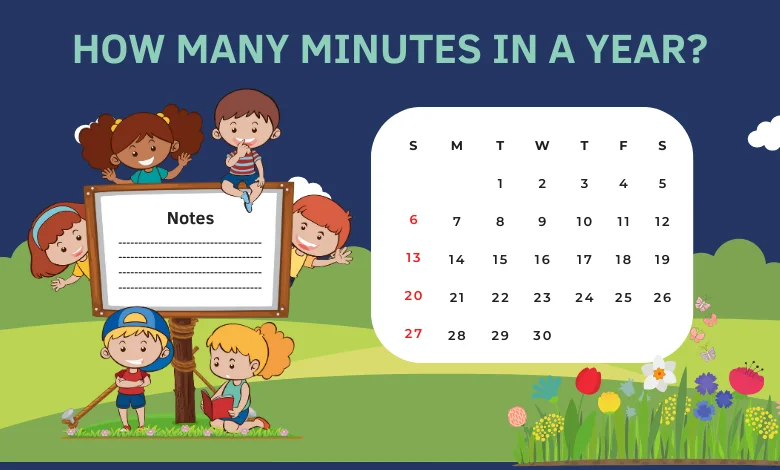“Counting the Minutes: Exploring the Concept of Time and How Many Minutes in a Year”

Time, the relentless force that governs our lives, is a concept deeply ingrained in human existence. From the rhythmic ticking of clocks to the passage of seasons, time shapes our experiences, defines our routines, and frames our memories. Among the myriad units of time, the minute stands as a fundamental measure, capturing fleeting moments and etching them into the tapestry of our lives. In this exploration, we delve into the intricacies of time, unravel the mystery of minutes, and ponder the intriguing question: how many minutes in a year?
The Essence of Time:
Time, often described as the fourth dimension, transcends physical boundaries and permeates every aspect of our reality. It is both tangible and intangible, fleeting yet eternal, a concept that has puzzled philosophers, scientists, and poets alike for centuries. Time governs the natural world, orchestrating the ebb and flow of tides, the cycle of day and night, and the rhythm of life itself.
Breaking Down the Year:
The journey to uncovering the number of minutes in a year begins with understanding the structure of time itself. A year, the time it takes for the Earth to complete one revolution around the Sun, is divided into various units, each marking a distinct interval in the cosmic dance of the universe. From days to weeks, months to seasons, the year unfolds in a symphony of time, each moment a fleeting note in the grand composition of existence.
Decoding Minutes:
In the realm of timekeeping, the minute emerges as a fundamental unit of measurement, capturing brief but meaningful intervals in the passage of time. Defined as the sixtieth part of an hour, the minute encapsulates sixty seconds of existence, each tick marking a momentary pause in the relentless march of time. From the mundane to the profound, minutes shape our daily routines, punctuating our lives with a rhythm that is both predictable and elusive.
Calculating the Total:
To determine the number of minutes in a year, we must first consider the components that make up a year. A common year consists of 365 days, while a leap year contains 366 days, with an extra day added in February to account for the Earth’s slightly longer orbit around the Sun. Each day comprises 24 hours, and each hour consists of 60 minutes.
For a common year: 365 days/year × 24 hours/day × 60 minutes/hour = 525,600 minutes
For a leap year: 366 days/year × 24 hours/day × 60 minutes/hour = 527,040 minutes
Significance of the Calculation:
The revelation that there are either 525,600 or 527,040 minutes in a year is more than just a mathematical curiosity; it underscores the intricate precision of the universe and the relentless passage of time. From the mundane routines of daily life to the grand sweep of history, each minute represents an opportunity—a chance to live, to love, to learn, and to grow.
Putting Time into Perspective:
While the concept of minutes may seem trivial in the vast expanse of cosmic time, it is the foundation upon which our lives are built. Every minute holds the potential for transformation, for connection, for enlightenment. From the breathtaking beauty of a sunset to the quiet solitude of a starlit night, time invites us to embrace the present moment, to savor the here and now, and to cherish the fleeting nature of existence.
Time Beyond Numbers:
Beyond the mathematical calculations and numerical precision lies a deeper truth about time—an intangible essence that transcends mere measurements. Time is not just a series of minutes, hours, and days; it is a journey—a passage through the boundless realms of space and consciousness. It is a reminder of our mortality, a celebration of our humanity, and a testament to the enduring power of the human spirit.
Conclusion:
In the tapestry of existence, time weaves a thread of continuity—a thread that binds the past, present, and future in a seamless continuum of experience. From the cosmic dance of celestial bodies to the quiet moments of introspection, time permeates every aspect of our lives, shaping our perceptions, guiding our actions, and illuminating our path through the vast expanse of the universe. And as we contemplate the number of minutes in a year, let us not forget the profound significance of each fleeting moment—the moments that define us, inspire us, and remind us of the timeless beauty of being alive.
How many minutes are there in a year?
There are 525,600 minutes in a common year and 527,040 minutes in a leap year.
What is the difference between a common year and a leap year?
A common year consists of 365 days, while a leap year contains 366 days. Leap years occur every four years, except for years that are divisible by 100 but not by 400.
Why does a leap year have an extra day?
A leap year has an extra day, known as February 29th, to account for the fact that the Earth’s orbit around the Sun is approximately 365.25 days. The additional day helps synchronize the calendar year with the astronomical year.
How do you calculate the number of minutes in a year?
To calculate the number of minutes in a year, you multiply the number of days in the year by the number of hours in a day (24) and then by the number of minutes in an hour (60).
Why is it important to know how many minutes are in a year?
Understanding the number of minutes in a year helps us appreciate the passage of time and better organize our schedules and routines. It also highlights the precision and consistency of our timekeeping systems.
What are some practical applications of knowing how many minutes are in a year?
Knowing the number of minutes in a year can be useful for various purposes, including scheduling appointments, planning events, calculating time-based metrics in business or science, and managing personal time effectively.
Is the concept of leap year universal across all cultures and calendars?
No, leap years are specific to the Gregorian calendar, which is the calendar system most commonly used internationally for civil purposes. Other cultures and calendars may have different methods for accounting for the discrepancy between the calendar year and the astronomical year.
Are there any variations in the number of minutes in a year due to different calendar systems?
Yes, the number of minutes in a year may vary slightly depending on the specific calendar system used. However, the Gregorian calendar is the most widely used and recognized calendar for determining the length of a year.
How accurate is the concept of leap year in synchronizing the calendar with the Earth’s orbit?
While the concept of leap year helps maintain alignment between the calendar year and the astronomical year, it is not perfect. The Earth’s orbit is not precisely 365.25 days long, leading to minor discrepancies over time that may require periodic adjustments to the calendar system.
Where can I find more information about the concept of leap year and calendar systems?
Additional information about leap years, calendar systems, and timekeeping methods can be found in books, online resources, and educational materials related to astronomy, history, and mathematics.
Also Read: https://primenewsartical.com/



